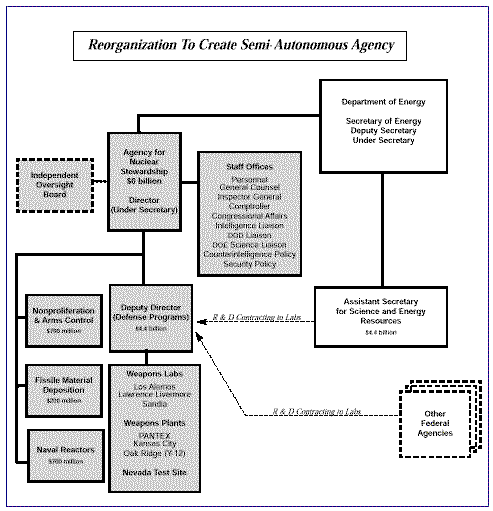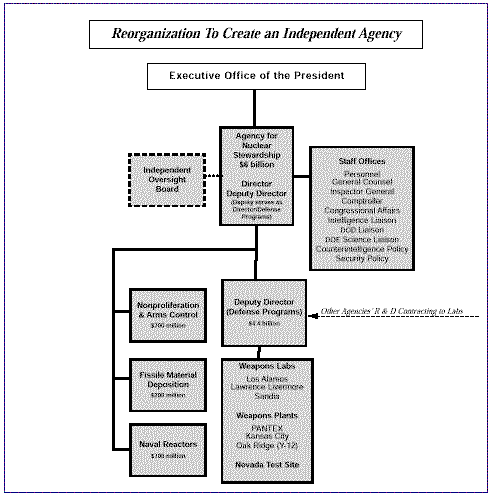

LEADERSHIP
Certainly at the top, but also throughout the organization. The leaders and managers set the standards and expectations regarding performance and accountability. They are the foundation upon which a successful organizational culture is built. If management sets, demonstrates and enforces high standards for performance and accountability, there is a strong likelihood that the organization will follow. And, longevity is a key ingredient. For example, Daniel S. Goldin, Administrator of the National Aeronautics and Space Administration (NASA), was named to his post in the spring of 1992. Goldin has won considerable acclaim for demanding nothing but the best from his employees, and thereby turning around a bureaucracy that had become ossified and recalcitrant to higher authority, including the President. He did not do it overnight, though. His �watch" is now seven years long and still going. By contrast, the average stay for an Energy Secretary has been about two and a half years; a Deputy Secretary, less than two years; and an Under Secretary, less than 18 months.1
CLARITY OF MISSION
Employees must know who they are and why they are there. Mission statements may seem corny to some, but from our experience good ones work. NASA�s is crisp, clear and bold: �NASA is an investment in America�s future. As explorers, pioneers and innovators, we boldly expand frontiers in air and space to inspire and serve America, and to benefit the quality of life on Earth." The Energy Department also declares itself a department of the future; it�s slogan is �Science, Security and Energy: Powering the 21st Century." However, we wonder if the DOE employees in the field really have a sense of purpose and direction. Those at the Oakland Operations Office are challenged to, �serve the public by executing programs and performing DOE contract management." At Albuquerque Operations Office, the rallying cry is, �to contribute to the welfare of the nation by providing field-level federal management to assure effective, efficient, safe and secure accomplishment of the Department�s national defense, environmental quality, science and technology, technology transfer and commercialization and national energy objectives."2
DEDICATION TO EXCELLENCE
It is the responsibility of leadership to emphasize continuously and top-to-bottom the absolute importance of quality of performance. People truly dedicated to excellence usually achieve it.
EMPHASIS ON CORE COMPETENCIES
Those agencies that constantly emphasize the business areas in which they must absolutely excel, usually do so. At NASA, we are told, rarely, if ever, does the Administrator give a speech in which safety is not emphasized. DOE has appropriately emphasized excellence in the quality of its scientific and technical work, but only recently has begun to emphasize security, and only in recent months has articulated the importance of counterintelligence. The panel was hard pressed to find either words mentioned in speeches by most of Secretary Richardson�s predecessors.
MINIMAL POLITICAL PRESSURES
Blessed is the government manager whose operations fall into only a handful of Congressional districts and under the purview of only a couple of oversight committees. It doesn't take a nuclear scientist to understand that the more Congressional districts and committees with which a federal agency must contend, the more it is politically whip�sawed in its priorities and stuffed with pork. We suspect the Department of Energy probably holds some federal records: its multitudinous and widely cast operations come under the scrutiny of no less than 18 Congressional committees and fund well-paying federal and contractor jobs in more than 50 congressional districts.
STREAMLINED FIELD OPERATIONS
In just about any endeavor, but especially in managing government contracts, simpler is better. Managing government contracts has become a major function in more and more agencies and departments as they seek to cut costs. We know of a few good examples of agencies where this effort is both efficient and effective.
One is the National Reconnaissance Office (NRO), a semi-autonomous Defense Department agency, which has long managed huge contracts with major industrial firms that have built and help operate our nation's surveillance satellites. The NRO, however, came under heavy fire several years ago for budget irregularities, partly as a result of tangled lines of bureaucratic authority. Today, after some substantial streamlining, multi-million dollar contracts are run out of program management offices at NRO Headquarters on a line of accountability leading directly to the contracting company. Rather than maintaining large field offices, the NRO employs only a handful of representatives in the field�typically only one or two people resident at their largest contractors. The rest is done from Washington. To manage their largest contracts, no more than 15 contracting officers�from worker�level to management �are involved. Some are worth several billion dollars. Currently, the NRO manages over 1,000 contracts worldwide, with a combined value numbering in the tens of billions of dollars. They manage these contracts using a staff of approximately 250 contract officers.3
Though we acknowledge that there are differences between the missions of NRO�s satellite contractors and DOE�s nuclear weapons lab contractors, we are stunned by the huge numbers of DOE employees involved in overseeing a weapons lab contract. For example, Sandia National Weapons Laboratory, a contractor�operated facility in New Mexico, has several layers of Energy Department employees with whom it must deal: the Kirtland (Air Force Base) Area Office, with about 55 �feds,� which is subordinate to the Albuquerque Field Office (AFO), which has a total complement of about 1,300 government workers. Albuquerque also monitors contracts with Los Alamos National Lab (through a Los Alamos Area Office of some 70 people), and several other contractors throughout the southern United States. Notably, Albuquerque is but one of 11 such DOE Field Offices, that boast a total field complement of about 6,000. Back at DOE Headquarters, which has a total work force of close to 5,000, Sandia�s contracts are monitored, depending on the subject, by several Program Offices�including Defense Programs (somewhat over 100 officials) and Environmental Management (somewhat over 200 officials).
We repeatedly heard from officials at various levels of DOE and the weapons labs how this convoluted and bloated management structure has constantly transmitted confusing and often contradictory mandates to the labs. This is vividly illustrated by the labyrinthine organizational charts that one must decipher to trace lines of authority.
RESPONSIBILITY AND ACCOUNTABILITY IN SECURITY
One senior CIA official told us that the NRO security system is the best in the government�a view echoed, we understand, in a forthcoming report by the DCI/Defense Secretary Joint Security Commission. One can see why. At the NRO, security starts at the top. The chief of security provides policy guidance and monitors implementation. However, from the Director on down, all line managers are responsible for implementation. If a security breach occurs, the Director and appropriate line subordinates all are accountable. Similarly, NRO contractors are expected to meet fully NRO security standards and guidelines. Failure to meet those guidelines could well result in forfeiture of performance award fees, at the least.
FULL OPERATIONAL INTEGRATION
To be effective, security must be more than a concept, it must be woven into every aspect of the agency�s business and the daily work of every employee. The NRO integrates security more fully than most other federal agencies we have seen. Though it has separate line items for security and counterintelligence functions, most security�related expenditures are integrated directly into the line items of every satellite program. Thus, rather than imposing security mandates as contract �add-ons," security officials work with the NRO managers to fold their requirements into a given program during the planning stages. In this structure, security requirements are as much a part of an NRO satellite program as are solar cells and thrusters. And, the NRO security professionals, rather than treated as staff functionaries, are accepted as true partners in the NRO mission.
A PREVAILING CONSCIOUSNESS
Making people aware is vital. The record clearly shows that DOE has had mixed results from its various security and counterintelligence indoctrination programs. Briefings, town hall meetings and educational films are helpful, but they cannot take the place of a working environment in which security is just part of the daily routine. Again at the NRO, when a management decision is made, security always gets a voice. A security official is present at every level of NRO decision making: from the Office Director, to his Board of Directors, to the management teams of the smallest NRO program, security officials are part of the management process. Moreover, �security" gets a vote equal to that of any program manager. From the record, we judge that security at DOE, until recently, only occasionally had a voice; and when it did, many managers vociferously objected. Counterintelligence, on the other hand, was allowed little more than a whisper.
RESTRUCTURING
The panel is convinced that real and lasting security and counterintelligence reform at the weapons labs is simply unworkable within DOE�s current structure and culture. To achieve the kind of protection that these sensitive labs must have, they and their functions must have their own autonomous operational structure free of all the other obligations imposed by DOE management. We strongly believe that this cleaving can best be achieved by constituting a new government agency that is far more mission�focused and bureaucratically streamlined than its antecedent, and devoted principally to nuclear weapons and national security matters.
The agency can be constructed in one of two ways. It could remain an element of DOE but become semi-autonomous�by that we mean strictly segregated from the rest of the depart-ment. This would be accomplished by having the agency director report only to the Secretary of Energy. The agency directorship also could be �dual-hatted" as an Under Secretary, thereby investing it with extra bureaucratic clout both inside and outside the department.
We believe there are several good models for this course of action: the National Security Agency and the Defense Advanced Research Projects Agency, both elements of the Defense Department; and the National Oceanographic and Atmospheric Administration, an agency of the Commerce Department. Alternatively, the agency could be completely independent, with its administrator reporting directly to the President. The National Aeronautics and Space Administration and the National Science Foundation are also good models.
Regardless of the mold in which this agency is cast, it must have staffing and support functions that are autonomous from the remaining operations at DOE. These functions, which report directly to the Director, must include: an inspector general; a general counsel; a human resources staff; a comptroller; a senior official responsible solely for security policy, and another responsible solely for counterintelligence policy. To protect its autonomy and avoid the diversion of funds to other purposes, the agency budget must be a separate line item strictly segregated by Congress from other budget pressures�even if it remains nominally within the current DOE structure. The agency also must have a separate employee career service. The panel recommends an �excepted service" model of employment, like many of the intelligence community elements, which would facilitate accountability and higher performance levels by allowing management to reward, punish, hire, and fire employees more easily.
To ensure its long�term success, this new agency must be established by statute. That statute, moreover, must clearly stipulate that nothing less than an act of Congress can amend the agency�s mission, functions or affiliations. Clearly, Congress and the President must decide definitively which of these two solutions to enact. The panel has no specific preference between them; we believe either can be made effective. Should Congress and the President conclude that retaining the agency inside DOE is not workable, the �wholly-independent" approach should be enacted.
We emphasize that it is very important for the new structure to be organized to preserve and, if possible, enhance the ability of the national weapons labs to attract and retain scientists of the highest caliber. Excellence in the caliber of the scientists and their research and development programs must be sustained if the weapons labs are to fulfill their missions in the front line of U.S. national security. To meet this goal, continued but carefully controlled interaction with foreign visitors and scientists from around the world as well as with researchers from DOE�s nondefense labs is essential for producing the best science. In the semi-autonomous model, the Secretary would be responsible for managing and ensuring the effectiveness of agency relations with the nonweapons labs.
Whichever solution Congress enacts, we do feel strongly that the new agency never should be subordinated to the Defense Department. Defense already is populated with a number of semi�autonomous agencies; we see no reason to add to that burden. Moreover, we believe the decision made long ago to house America�s nuclear weapons research and development in a civilian government agency still makes sense. Specifically, we recommend that the Congress pass and the President sign legislation that:
A Semi-Autonomous or Wholly Independent Nuclear Weapons Stewardship Agency should have the following attributes:


2. DOE, Field Fact Book, May 1998.
3. Unclassified organizational data provided by National Reconnaissance Office.